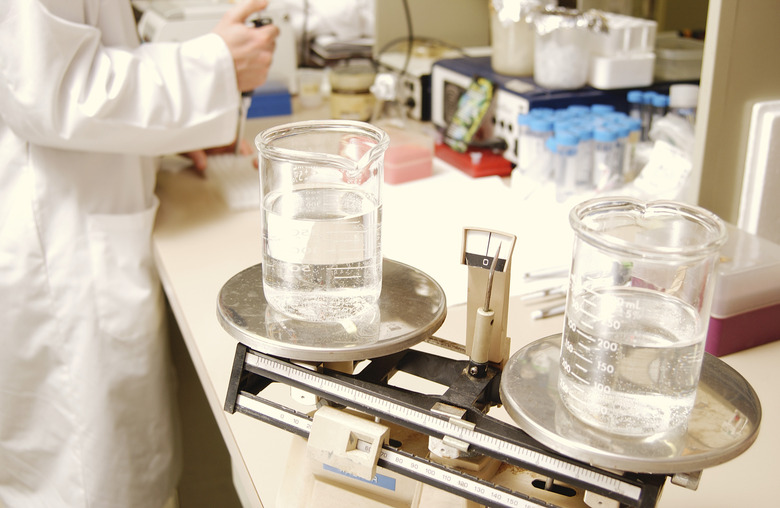How To Convert Hydrogen & Oxygen Into Water
"Water" is the common name for the compound dihydrogen oxygen or "H2O," which consists of two hydrogen atoms covalently bonded to a single oxygen atom. While water can be formed through countless chemical reactions, the most efficient way to create a water molecule out of oxygen and hydrogen atoms is to burn hydrogen gas (H2) in the presence of oxygen gas (O2). However, the H2O molecules created will exist as a gas (i.e., steam); to make this energized matter condense into liquid form (i.e., water), it must be collected and cooled to room temperature.
Setting Up The Gas Supply
Step 1
Attach one 2-foot-long piece of latex rubber tubing to the oxygen tank's control valve outlet.
Step 2
Attach one 2-foot-long piece of latex rubber tubing to the hydrogen tank's control valve outlet.
Step 3
Attach the inlet opening of a check valve to the end of the tubing leading to each tank.
Step 4
Attach a new 2-foot-long piece of tubing to the outlet opening of each check valve.
Step 5
Attach the free end of each of these new pieces of tubing to one of the inlets of the Y-connector. Note: Basically, you've just built a system that will allow you to safely mix the two gases in controlled ratios.
Step 6
Use a 3-foot-long piece of tubing to attach the remaining outlet opening of the Y-connector to the inlet of the Bunsen burner.
Setting Up The Collection Apparatus
Step 1
Place the funnel upside-down over one end of the aluminum duct and secure it with the aluminum foil tape around the entire edge. Make sure that the lip between the edge of the funnel and the edge of the duct is completely sealed.
Step 2
Fit a 6-inch-long piece of the latex rubber tubing onto the opening of the funnel and then secure it with the aluminum foil tape.
Step 3
Attach the inlet of a new check valve to the other end of the 6-inch piece of tubing.
Step 4
Attach a 2-foot-long piece of tubing to the outlet of the check valve.
Step 5
Attach the other end of this tubing to the inlet of the 750 mL Buchner flask.
Step 6
Gently push the rubber stopper into the top of the 750 mL Buchner flask. Do not jam or force the stopper into the opening.
Step 7
Put the tub filled with ice water on top of the table.
Step 8
Submerge 75 percent of the flask into the tub filled with ice water.
Collecting The Water
Step 1
Place the Bunsen burner on the floor, a foot away from the table.
Step 2
Twist the Bunsen burner to the "Ignition" setting.
Step 3
Gently release the hydrogen tank's control valve, allowing a small stream of hydrogen gas to start flowing though the tubing.
Step 4
Strike a match and hold it 2 inches above the Bunsen burner's top opening. Note: For your own safety, hold the match at arm's length.
Step 5
If the match goes out before the burner can ignite, quickly turn off the gas and run the burnt match under a stream of water to fully extinguish it. Then re-attempt Steps 3 and 4.
Step 6
If the Bunsen burner's flame does ignite, twist the burner to reduce the size of the flame.
Step 7
Gently release the oxygen tank's control valve, again allowing only a small stream of gas.
Step 8
Once both the hydrogen and oxygen are flowing, place the open end of the 3-foot duct over the entire Bunsen burner. The super-heated H2O made by the flame will rush up to the funnel and into the tubing, where the check valve will trap it in the tubing leading to the chilled Buchner flask. The steam will expand into the flask, where the ice-chilled walls will drain energy from the molecules, causing them to condense into droplets and collect at the bottom of the flask.
Step 9
After enough water has collected in the Buchner flask, shut off the control valves on the hydrogen and oxygen tanks.
Step 10
Disassemble the apparatus and clean up the area.
Things Needed
- Tank of pressurized oxygen gas with control valve
- Tank of pressurized hydrogen gas with control valve
- Y-connector valve
- 3 feet of 4-inch-wide aluminum duct
- 4-inch-wide aluminum funnel
- 30 feet of latex rubber tubing
- 3 inline check valves
- Bunsen burner
- 1.5-inch-wide aluminum foil duct tape
- 750 mL Buchner flask
- Rubber stopper
- Tub of ice water
- Matches
- Table at least 3 feet in height
Warning
Keep the gas flow low. Burning too much hydrogen at once will make the flame (and gaseous H2O) hot enough to melt the tubing.
Cite This Article
MLA
Pasquesi, Andy. "How To Convert Hydrogen & Oxygen Into Water" sciencing.com, https://www.sciencing.com/convert-hydrogen-oxygen-water-5855262/. 24 April 2017.
APA
Pasquesi, Andy. (2017, April 24). How To Convert Hydrogen & Oxygen Into Water. sciencing.com. Retrieved from https://www.sciencing.com/convert-hydrogen-oxygen-water-5855262/
Chicago
Pasquesi, Andy. How To Convert Hydrogen & Oxygen Into Water last modified August 30, 2022. https://www.sciencing.com/convert-hydrogen-oxygen-water-5855262/
